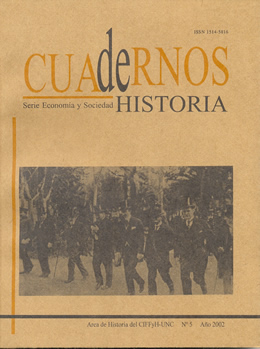State-border region articulation in the Misiones or Palmas area
DOI:
https://doi.org/10.53872/2422.7544.n5.9908Abstract
The conformation of the Misiones space is an illustrative example of the intertwining of international and interregional relations that took place in various Latin American border regions, which functioned as a totality liable to occupation and displacement, historically linked to the area currently comprising southern Brazil, the Argentine and Uruguayan Mesopotamia, as well as a large part of what was the former Spanish governorate of Asunción. In order to develop this perspective of analysis, we take as a starting point the concept of region, considering its character as a methodological instrument with its corresponding anchorage in reality, that is, the relationship between space and the political, economic and socio-cultural phenomena that occur there. In other words, this concept is constructed in relation to the object of study, which shows its temporal and spatial dynamism. In this regard, we consider borders as a specific case of region. That is, as "plurinational spaces", subject to appropriation and control by more than one State, which implemented power strategies in order to impose their authority and disputed among themselves for their dominion, and as regional spaces - with their own dynamics - that generated responses to the policies of each of the State entities in which they were incorporated. The existence of these interactions between what we can call "complementary opposites" allows us to broaden the horizon of analysis by observing the inter-influence between "international relations" and "inter-regional relations", applied in this study to the specific case of the Misiones region. As for the temporal axis, although the interest is focused on the period of territorial conformation of the States in which the Misiones region is inserted, we believe that in order to explain the regional reality of the time, it is necessary to approach the distinctive elements that marked its occupation process.
References
Arquivo Histórico do UItamaraty – Seção Correspondência – Misões Diplomaticas Brasileiras Ofícios – 206-1-11.
Azara, Felix de, 1847, Descripción e Historia del Paraguay y del Río de la Plata, publicada por Agustín Azara, Madrid, 1847, 2 Vol.
Bandieri, Susana. 2001, “La posibilidad operativa de la construcción histórica regional o cómo contribuir a una historia nacional complejizada”, Fernández, S. y Dalla Corte, G. (comp.), 2001, Lugares para la Historia. Espacio, Historia Regional e Historia Local en los Estudios contemporáneos, Universidad Nacional de Rosario, Rosario.
Barret, Rafael, 1978, Lo que son los Yerbales. El Dolor Paraguayo, Biblioteca Ayacucho, Caracas.
Bolsi, Alfredo, 1976, El proceso de poblamiento pionero en Misiones (1830-1920). Folia Histórica del Nordeste. Resistencia - Corrientes, Nº 2, 1976, p. 9 a 69.
Bruniard, Enrique y Bolsi, Alfredo, 1992, Región agro - silvo - ganadera con frentes pioneros de ocupación del Nordeste. Roccataggliata, Juan (coord.). La Argentina. Geografía general y los marcos regionales, Planeta, Buenos Aires, p. 527-577.
Campi, Daniel, 2001, Historia Regional ¿Por qué?. Fernández, S. y Dalla Corte, G. (comp.) 2001, Lugares para la Historia. Espacio, Historia Regional e Historia Local en los Estudios contemporáneos, Universidad Nacional de Rosario, Rosario.
Cervo, Amado, 1981, O Parlamento Brasileiro e as Relações Exteriores (1826-1889), Editora Universidade de Brasilia.
Denis, Pierre, 1987, La valorización del país. La República Argentina 1920, Ed. Solar, Buenos Aires.
Dobrizhoffer, Martín, 1967-1970, Historia de los Abipones, Facultad de Humanidades, Universidad Nacional del Nordeste, Resistencia.
Fernández, Sandra. y Dalla Corte, Gabriela. (comps.), 2001, Lugares para la Historia. Espacio, Historia Regional e Historia Local en los Estudios contemporáneos, Universidad Nacional de Rosario, Rosario
Garavaglia, Juan C., 1983, Mercado Interno y Economía colonial, Grijalbo, México.
Heredia, Edmundo (dir), 1994 América Latina. Isla o Archipiélago. El rol de las vía de comunicación en la estructuración espacial latinoamericana, Universidad Nacional de Córdoba., Córdoba.
Huret, Jules, 1986, De Buenos Aires al Gran Chaco, Hyspamérica, Madrid.
Martinez Sarasola, Carlos, 1992, Nuestros Paisanos. Los Indios, Emecé, Buenos Aires,
Memoria del Ministerio de Relaciones Exteriores, Republica Argentina, 1895, Buenos Aires.
Memoria del Ministerio de Relaciones Exteriores, Republica Argentina, 1900, Buenos Aires.
Paranhos, José María da Silva (Baron de Rio Branco), 1945, Questões de Limites – República Argentina, Ministério das Relações Exteriores, Rio de Janeiro, Obras Completas.
Petrone, María Teresa Schorer. Inmigração. Boris, Fausto. História Geral da civilização Brasileira. O Brasil Republicano. Sociedad e Instituções (1889-1930), Bertrand Brasil, Rio de Janeiro, Tomo III, Vol. 2, p. 93 a 133
Rex González, Alberto y Perez, José, 1985, Argentina indígena, vísperas de la conquis- ta, Piados, Buenos Aires,
Ribeiro, Darcy, 1985, Las Américas y la Civilización, C.E.A.L., Buenos Aires. Schmieder, Oscar, 1946, Geografía de América. F.C.E. México.
Soares, Alvaro Teixeira, 1972, História da Formação das Fronteiras do Brasil, Conselho Federal de Cultura, Rio de Janeiro.
Zeballos, Estanislao, 1894, Alegato de la República Argentina sobre la cuestión de límites con el Brasil en el territorio de Misiones, sometida al Presidente de los Estados Unidos, Washington.
Downloads
Published
Issue
Section
License
Copyright (c) 2014 Cuadernos de historia. Serie Economía y Sociedad

This work is licensed under a Creative Commons Attribution 4.0 International License.
Authors publishing in this journal accept the following terms:
a. The author maintains their copyrights and grants this journal the publication of the first original version of their work that is subject to the Creative Commons Attribution License 4.0. This license agreement allows:
Sharing — copy and redistribution of the published material by any means and formats
Reusing — remix, change, and creation of new material from the published work for any purpose, including commercial use.
b. Authors may enter other non-exclusive license agreements of distribution of the version of the published work (i.e. uploading the material on an institutional virtual archive or republishing it on a monographic volume) as long as they attribute the publication of the original version to this journal.
c. It is allowed and recommended that authors publicize their work on the Internet (i.e. on institutional virtual archives or on their personal or professional websites) after their work has been published in this journal.




